For hunters with limited mobility, focus on scopes with digital displays, intuitive controls, and quick-adjust features. Choose lightweight options with large tactical turrets that don’t require fine motor skills. Mount your scope on integrated shooting platforms like the XOP INVADER or JX3 Hybrid that allow comfortable seated shooting. Smart scopes with ballistic calculation features can compensate for stability challenges by reducing dependency on physical stabilization. The right equipment adaptations can transform your hunting experience despite mobility limitations.
Understanding the Challenges of Limited Mobility in Hunting
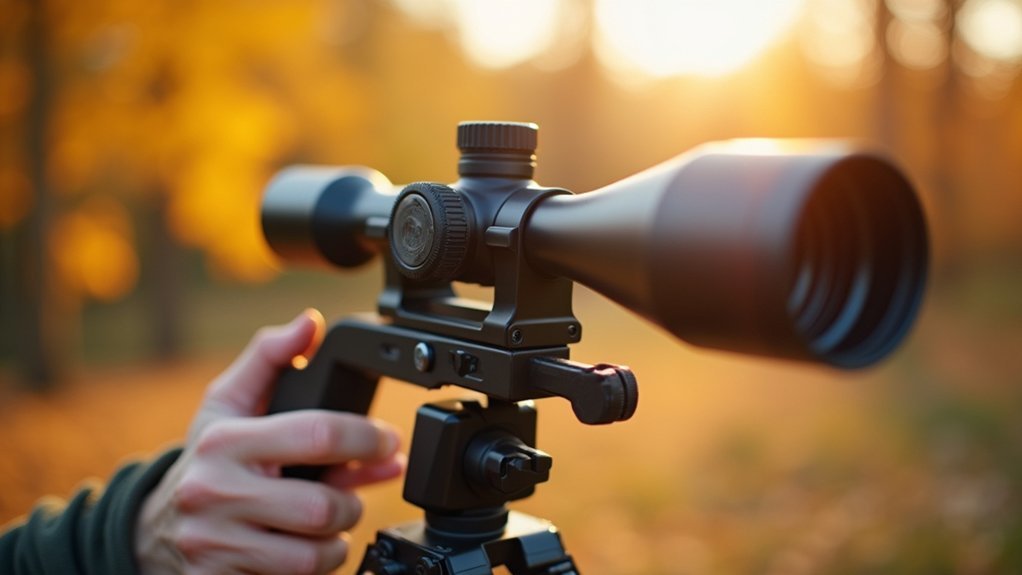
While hunting demands physical endurance and precise movement, hunters with limited mobility face unique obstacles that transform the experience.
You’ll encounter difficulties maintaining the stable posture needed for accurate shots, as muscle weakness and joint restrictions impair your ability to hold a rifle steady. Research shows that adequate access is essential for all hunters, but particularly critical for those with mobility limitations. Fine motor control for trigger pulls and scope adjustments becomes challenging with neurological or musculoskeletal impairments.
Your hunting strategy naturally shifts toward stationary setups rather than active stalking, often limiting your effective hunting area. Standard shooting positions may be impossible, while body sway increases, affecting sight alignment.
Environmental factors like uneven terrain compound these difficulties. Despite regulatory accommodations, physical access to hunting locations remains problematic, with many sites lacking properly designed accessible blinds or stands.
Selecting the Right Scope for Your Mobility Needs
Selecting the appropriate scope for your limited mobility needs requires thoughtful consideration of both your physical capabilities and the adaptive technologies available. Evaluate your specific limitations and prioritize features that address these challenges directly.
When choosing a scope, focus on:
- Display versatility – LCD screens that can be positioned at various angles for comfortable viewing
- Mounting options – compatibility with tripods, gun rests, or rail systems for enhanced stability
- User interface – intuitive controls that don’t require fine motor skills or complex manipulation
Digital scopes with recording capabilities often provide greater accessibility than traditional optical models. The Digital Crosshairs 1000SA model offers excellent accessibility with its real-time targeting display on a 4.3-inch LCD screen. If you have visual impairments, look for scopes with enhanced digital crosshairs and high-contrast displays.
For mobility issues, prioritize lightweight models that can be operated without requiring significant physical adjustment or repositioning.
Mounting Solutions That Reduce Physical Strain
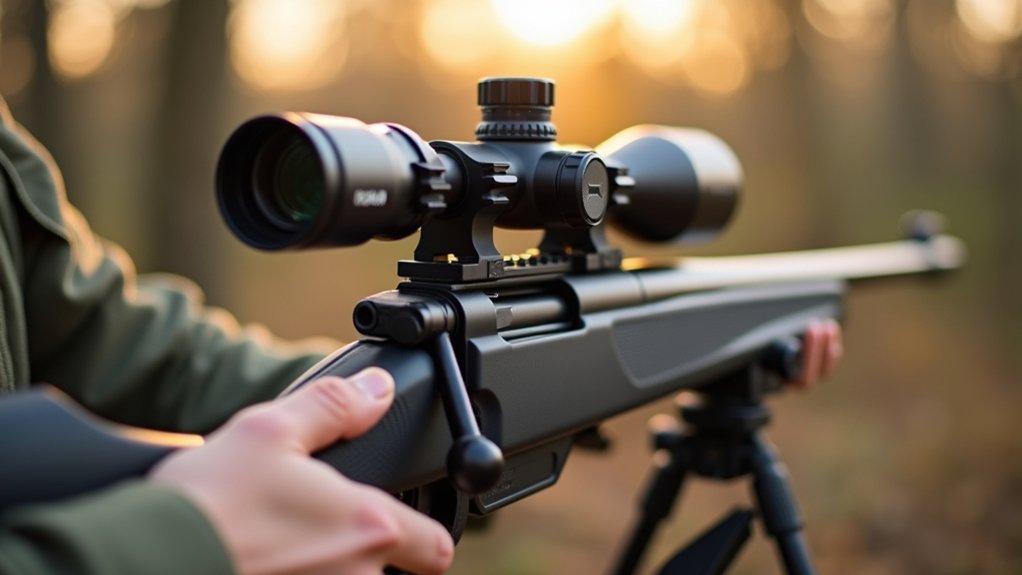
You’ll find quick-detach mounts invaluable for easily removing and attaching optics without compromising zero, perfect when your mobility fluctuates day-to-day.
The targeting display can be positioned at a comfortable distance from the shooter, making it accessible for those with limited range of motion or dexterity issues.
Integrated shooting platforms combine your scope mount with specialized rests or tripods, creating a thorough system that minimizes physical adjustment and strain.
Lightweight mounting setups, often made from aircraft-grade aluminum or carbon fiber, greatly reduce overall weight and combat fatigue during extended hunting sessions.
Quick-Detach Mount Benefits
For hunters with limited mobility, quick-detach mounts represent one of the most practical innovations in scope mounting technology.
These mounts allow you to remove and reattach scopes without losing zero, greatly reducing physical strain on your hands and wrists during setup and transportation. Many hunters appreciate the zero retention capabilities these mounts offer when properly installed.
You’ll appreciate how these mounts can simplify your hunting experience with:
- Minimal Physical Effort – Easy operation with gloved hands through simple lever or button mechanisms
- Versatile Application – Switch between different optics without needing multiple firearms
- Reduced Equipment Load – Carry less overall weight by detaching scopes for separate storage
The user-friendly design enables quick changes between setups while maintaining precision alignment.
For those with mobility challenges, these mounts offer independence and adaptability across diverse hunting environments and emergency situations.
Integrated Shooting Platforms
Integrated hunting platforms represent a significant advancement for limited mobility hunters, combining stability features with ergonomic designs that substantially reduce physical strain during extended hunting sessions.
You’ll find options like the XOP INVADER with 35-degree adjustability and the JX3 Hybrid Hunting Saddle allowing 360-degree shooting while seated comfortably.
These platforms incorporate traction-enhancing features such as AXIOM teeth, sand-imbedded powder coatings, and textured surfaces to guarantee secure positioning in various weather conditions.
Many models support hands-free or one-handed operation, with Be Adaptive equipment featuring Picatinny rail mounts that operate with minimal effort. The highly-rated High Quad Mount provides exceptional stability for shooters with limited upper body mobility, offering comprehensive support at $2,750.
Ultra-lightweight designs—like the RZR Sub2 at just 1.95 pounds—minimize transport fatigue, while compact, foldable configurations help you access remote locations without excessive physical exertion.
Fatigue-Reducing Lightweight Setups
Lightweight mounting solutions have emerged as a game-changer for hunters with limited mobility, directly addressing the physical strain of extended field sessions.
Modern options like Talley Lightweight Alloy Mounts and Aero Precision systems use 6000 series alloys and CNC machining to maintain durability while notably reducing weight—some weighing just 5 ounces.
When selecting fatigue-reducing mounts, consider:
- One-piece designs that enhance stability while eliminating unnecessary weight
- Quick-detach features that minimize handling time and effort
- Modular options that allow for personalized adjustment to your specific limitations
The right lightweight mount doesn’t just reduce overall rifle weight; it improves balance and reduces the need for constant repositioning, allowing you to maintain your shooting position with considerably less strain. American Defense Manufacturing offers options like the Aimpoint Micro T1/T2 Lightweight Mount at $138.86, providing excellent TAC Lever functionality for hunters who need reliable quick-detach capability.
Smart Scopes: Technology That Compensates for Movement Limitations
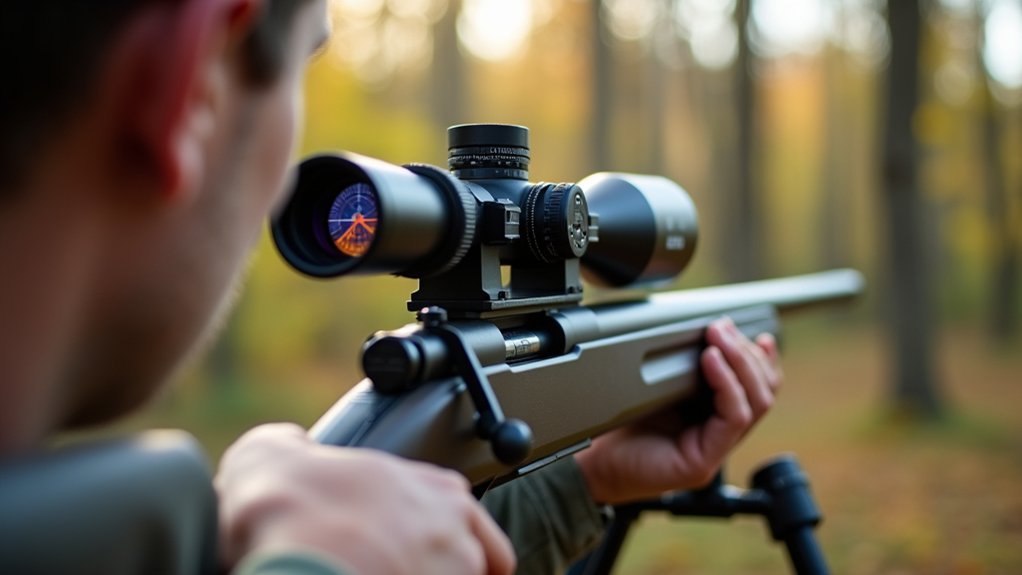
While traditional scopes require steady hands and precise positioning, smart scopes have revolutionized hunting accessibility through advanced technology that compensates for movement limitations.
These innovative tools provide real-time ballistic calculations, automatically adjusting for wind, distance, and target speed—eliminating complex manual calculations that can be challenging with mobility restrictions.
Smart scopes like the Digital Crosshairs Adaptive Rifle Scope Clip-on enable you to participate more independently in hunting activities. The technology offers instant access to bullet drop compensation and windage adjustments, reducing your dependency on physical stabilization.
You’ll appreciate the ability to save multiple profiles for different ammunition or conditions. The integration of connectivity modules allows these scopes to communicate with external devices for enhanced data collection and improved performance.
When paired with thermal detection and night vision capabilities, these scopes further enhance your shooting experience, allowing quicker target engagement despite physical limitations.
Customizing Eye Relief and Exit Pupil for Comfort
Proper eye relief and exit pupil adjustments can dramatically enhance shooting comfort for hunters with mobility limitations.
Position your scope forward or backward on adjustable rails to find the ideal distance from your eye, reducing strain during extended shooting sessions. For better visibility, match the exit pupil size to lighting conditions—larger exit pupils work best in low light situations. Digital Crosshairs technology has revolutionized scope accessibility for mobility disabled hunters by providing flexible mounting options for targeting displays.
Optimize your scope position on adjustable rails for comfort, and select exit pupil size based on available light.
- Use cantilever mounts to extend your scope forward, creating additional eye relief without compromising your shooting position.
- Consider scopes with longer eye relief technology specifically designed for shooters with limited range of motion.
- Adjust your magnification levels strategically—lower settings typically provide larger exit pupils and wider fields of view.
These customizations allow you to maintain accuracy while reducing physical strain, making hunting more accessible and enjoyable.
Adaptive Shooting Positions and Supports
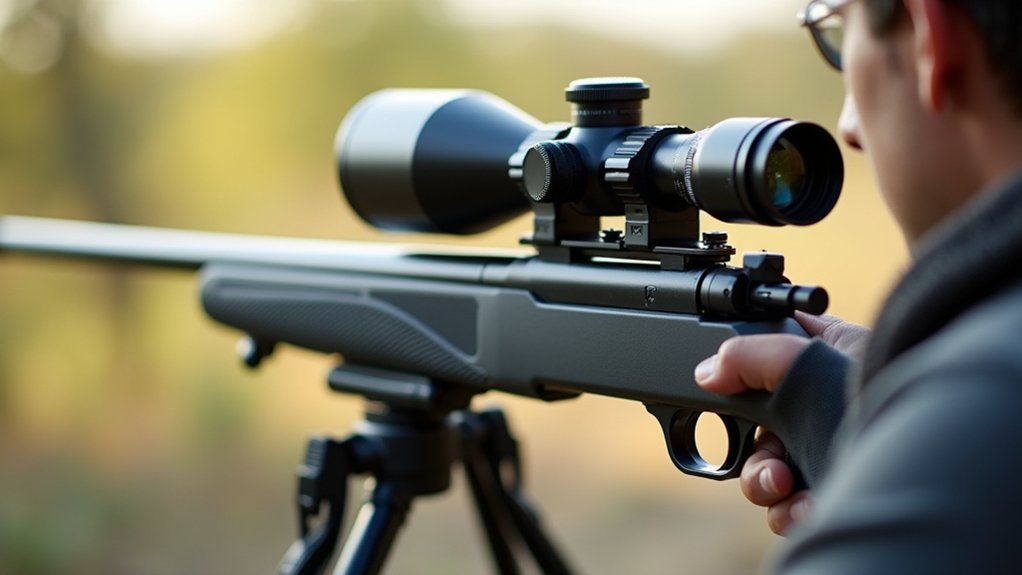
Hunters with mobility limitations can achieve remarkable accuracy by adapting their shooting positions and using specialized supports. Standard seated positions work well if you’re shooting from a wheelchair, while modified stances with chairs or rests accommodate various mobility challenges.
Consider utilizing gun rests, shooting sticks, or monopods to maintain a steady aim. These supports, combined with proper breathing techniques and muscle relaxation, greatly improve stability. Three-legged shooting sticks are particularly effective as they provide superior stability over terrain compared to single or double-legged versions.
Wheelchair-accessible platforms provide both comfort and a solid foundation for your shot.
For additional assistance, explore adaptive grip devices and customizable mounts that allow for personalized equipment setups. Many organizations offer training programs specifically designed for adaptive shooting, providing professional guidance in a supportive community environment.
These adaptations not only enhance your shooting experience but also build confidence in your hunting abilities.
Reducing Rifle Weight to Enhance Maneuverability
Beyond positioning and supports, the weight of your hunting equipment plays an essential role in shooting success for those with mobility challenges.
Lightweight components can transform your hunting experience by reducing fatigue and improving maneuverability.
Every ounce saved translates to extended field time and enhanced mobility when it matters most.
Focus on these key weight-saving strategies:
- Select synthetic stocks weighing 2-2.5 pounds that balance lightness with proper recoil management
- Choose compact optics with smaller objective lenses and streamlined mounting hardware
- Utilize modern materials like carbon fiber, polymer composites, and aluminum alloys in rifle components
Even removing one pound from your setup creates noticeable benefits during extended hunts.
Modern lightweight rifles averaging 5-6 pounds offer significant advantages for hunters with limited mobility without sacrificing necessary accuracy.
Pay attention to weight distribution, as proper balance is equally important.
Avoiding excessive rearward weight will make your rifle easier to steady and control, particularly important when mobility is limited.
Vibration Control and Recoil Management Techniques
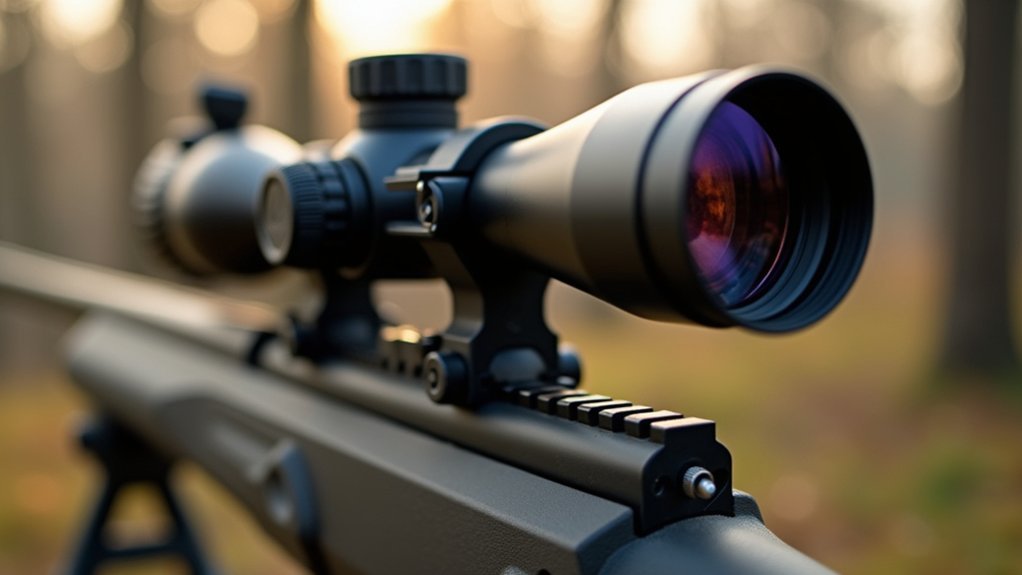
For mobility-limited hunters, managing a rifle’s vibration and recoil can make the difference between a successful shot and a frustrating miss. When you’re dealing with physical limitations, these forces become even more challenging to control.
Secure your scope with robust mounting systems that won’t shift during recoil. Consider adding adjustable weights to your barrel to tune vibrations for your specific shooting style. These weighted elements can greatly improve stability without compromising maneuverability. Remember that all scopes are essentially mechanical devices with similar internal functions that respond to physical forces.
Don’t overlook your stock’s importance—those with recoil-dampening materials can reduce felt impact. Maintain a firm but not overly tight grip to better manage kickback. For additional support, damping pads and external stabilizers can absorb unwanted movement.
Regular practice with proper technique will help you develop muscle memory that compensates for recoil, even with limited mobility.
Quick-Adjust Features for Users With Dexterity Challenges
Dealing with dexterity challenges shouldn’t prevent anyone from enjoying hunting experiences, which is why quick-adjust features on modern scopes have become essential accessibility tools.
Today’s scopes offer large, tactile turrets with audible clicks that require minimal fine motor control while providing precise adjustments.
Look for these user-friendly features:
- Locking turrets with zero-reset capabilities that let you quickly return to your baseline settings without recalibration
- Push-button or electronic controls that minimize the strength needed for adjustments
- Large eyebox designs with generous eye relief that reduce the need for exact positioning
First focal plane reticles maintain accuracy across magnification changes, eliminating the need to recalculate when zooming.
Bluetooth connectivity even allows remote scope programming through smartphone apps, further reducing physical demands.
The Eliminator series includes a wireless Bluetooth remote that allows users with limited mobility to activate the laser rangefinder without awkward repositioning.
Field-Testing Your Setup: Real-World Adaptations
Once you’ve selected appropriate equipment for your specific mobility needs, field-testing becomes critical to confirm your hunting setup performs reliably under real-world conditions.
Test your scope’s stability by evaluating how it handles recoil and accidental drops—these cumulative effects determine long-term reliability.
Consider integrating adaptive technologies like Digital Crosshairs, which benefit visually impaired hunters by providing clear targeting displays.
For limited mobility, explore gun rest modifications and adjustable mounting systems that can be customized to your specific needs.
When field-testing, verify consistent and repeatable evaluation under variable conditions including fog, rain, and extreme temperatures.
To ensure reliability, check that your scope maintains zero retention after being subjected to drops, as this is often overlooked despite being crucial for accuracy.
This thorough testing builds confidence in your equipment’s performance while supporting ethical hunting practices.
Remember that adaptations like tripods and ergonomic designs markedly improve usability for those with mobility challenges.
Maintenance Strategies for Users With Limited Strength
Maintaining hunting scopes presents unique challenges for individuals with limited strength, though proper planning and specialized tools can make these tasks manageable.
Proper planning and specialized tools transform scope maintenance from challenging to manageable for those with strength limitations.
Select scopes with robust yet simple mechanisms that require minimal force to adjust. Consider investing in adaptive equipment designed specifically for limited mobility users—these tools often provide better leverage and grip.
For effective maintenance with limited strength:
- Use protective cases and lens covers to prevent damage, reducing the frequency of difficult maintenance tasks
- Opt for scopes with easy-to-manipulate turrets and adjustment mechanisms made from durable materials
- Establish a regular cleaning schedule using lightweight tools rather than attempting infrequent, more intensive maintenance sessions
- Look for scopes that feature nitrogen purging technology to minimize internal fogging issues that would require complex disassembly
Remember that manufacturer support services and online communities can provide valuable guidance on maintenance techniques tailored to your specific needs.
Community Resources and Support Groups for Adaptive Hunters
The hunting community has developed robust networks of support for hunters with mobility limitations, creating pathways to outdoor experiences that might otherwise seem inaccessible.
National organizations like Buckmasters’ American Deer Foundation offer grants for equipment and organize group hunts, while Hunt of a Lifetime fulfills hunting dreams for youth under 21.
You’ll find regional assistance through groups like North Carolina Handicapped Sportsmen, Capable Partners in Minnesota, and Global Opportunities Unlimited in New Mexico.
These organizations provide guides, volunteers, and equipment sharing opportunities to enhance your hunting experience. Organizations like United Special Sportsman Alliance offer healing opportunities through outdoor activities for those recovering from illness, injury, or disability.
The NRA’s Adaptive Hunting Database can connect you with specialized outfitters, while community platforms like BADF’s Facebook page keep you informed about upcoming adaptive hunts and equipment exchanges in your area.
Frequently Asked Questions
How Do Extreme Weather Conditions Affect Adaptive Hunting Scope Setups?
Extreme weather can affect your adaptive hunting scope by causing fogging, reducing visibility, and stressing mounts. You’ll need nitrogen-purged lenses and weatherproof materials for consistent performance in both hot and cold conditions.
Can Voice Control Technology Be Integrated With Smart Hunting Scopes?
Yes, you’ll find voice control technology can be integrated with smart hunting scopes. It enables hands-free adjustments like zoom and turret dialing, while reducing battery life and requiring specialized hardware and software integration.
What Insurance Considerations Exist for Expensive Adaptive Hunting Equipment?
You’ll need specialized insurance for expensive adaptive hunting equipment. Consider equipment-specific policies, document your gear with photos, and explore grants from organizations like Buckmasters that help offset costs and premiums.
How Do Prescription Eyeglasses Interact With Specialized Hunting Scopes?
Your prescription eyeglasses work well with hunting scopes that have adequate eye relief. You’ll need at least 3-4 inches of eye relief for comfort, and you should position your glasses closer to the scope’s eyepiece.
Are There Scope Options Specifically Designed for One-Handed Operation?
Yes, you’ll find thermal imaging scopes with one-handed operation features, costing around $2,000-$2,500. Some riflescopes also offer ergonomic designs with centralized controls and unique arrangements specifically designed for one-handed use.
In Summary
Hunting is your right, regardless of mobility challenges. You’ve now got the tools to stabilize your scope, reduce strain, and enhance accuracy. Don’t hesitate to try new technologies and customizations that work for your specific needs. Connect with adaptive hunting communities to share experiences and discover innovations. With these strategies, you’ll continue enjoying successful hunts for years to come.





Leave a Reply